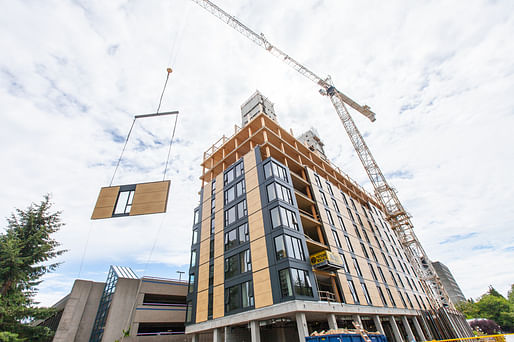
Completed last year, the wooden skyscraper opened its doors to 400 students at University of British Columbia (UBC) Campus in Vancouver. Designed by Acton Ostry Architects in collaboration with structural engineers Fast + Epp. The building is built of mass timber construction above one level of concrete and two concrete stair cores. The mass timber hybrid structure is 18 stories and 178 feet tall.

“The floor structure is comprised of 5-ply CLT panels supported on glue-laminated timber (glulam) columns on a 2.85 X 4.0 meter grid. This results in the CLT panels acting as a two-way slab diaphragm, which eliminates the need for load-carrying beams. To avoid a vertical load transfer through the CLT panels, a steel connector allows for a direct load transfer between the columns and also provides a bearing surface for the CLT panels”
Design and construction teams had to work hand in hand from the beginning of the design process, using 3D modeling to create and test the system. This new construction technique allowed reducing timelines, saving cost on both material and on time. Because the timber-prefabricated pieces are fast to assemble, the entire building was finished in nine and a half weeks – an average of four months faster than for a building of this size.
Wood is a strong, sustainable and local grown material in BC. Santa J. Ono president of the university says, “Wood is increasingly recognized as an important, innovative and safe building material choice. This new tall wood building reflects UBC’s leadership in sustainable construction and our commitment to providing our students with more on campus housing.”
Watch the video of the project below:
This article gives a nice overview of the major research and design efforts of CLT in North America. It even has an excerpt on this building:
Brock Commons at University of British Columbia
(UBC), Vancouver BC
This 18-story wood-concrete hybrid building is under
construction and is planned as the first phase of the new
690-bed UBC student housing complex. The ability for
UBC to permit building construction as an independent
jurisdiction made this ambitious venture possible. This
building that is part of the NRCan’s tall wood
demonstration building initiative, will be 174 feet (53m)
high and take the title of the tallest wood building in
North America at the time of completion (fall 2017). The
structural design for gravity loads feature CLT floor
panels as two-way slabs supported on a glulam column
grid [15]. The columns at each story transfer the axial
load directly to the column below through steel bearing
connection to avoid crushing of the CLT floor panels
under compression perpendicular to wood grain loads.
The lateral loads are resisted by a concrete building core.
The design team is targeting at LEED Gold certification
for the building’s energy performance.
All 2 Comments
probably not included in the Chicago Biennial.
Beautifully done, love glulam. With all the special protections needed probably not good for the masses, but nice in certain cases
This article gives a nice overview of the major research and design efforts of CLT in North America. It even has an excerpt on this building:
Brock Commons at University of British Columbia
(UBC), Vancouver BC
This 18-story wood-concrete hybrid building is under
construction and is planned as the first phase of the new
690-bed UBC student housing complex. The ability for
UBC to permit building construction as an independent
jurisdiction made this ambitious venture possible. This
building that is part of the NRCan’s tall wood
demonstration building initiative, will be 174 feet (53m)
high and take the title of the tallest wood building in
North America at the time of completion (fall 2017). The
structural design for gravity loads feature CLT floor
panels as two-way slabs supported on a glulam column
grid [15]. The columns at each story transfer the axial
load directly to the column below through steel bearing
connection to avoid crushing of the CLT floor panels
under compression perpendicular to wood grain loads.
The lateral loads are resisted by a concrete building core.
The design team is targeting at LEED Gold certification
for the building’s energy performance.
Block this user
Are you sure you want to block this user and hide all related comments throughout the site?
Archinect
This is your first comment on Archinect. Your comment will be visible once approved.